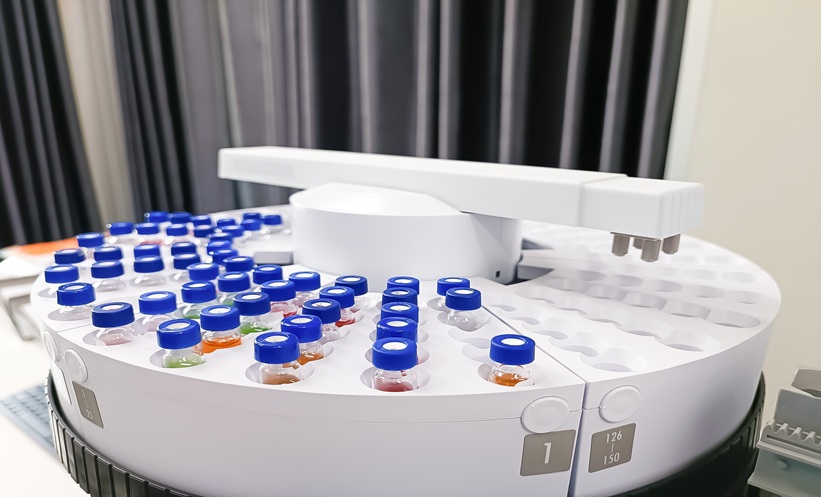Author: Oluseyi Abidoye,1 *Mohamad Bassam Sonbol1
1. Mayo Clinic Cancer Center, Phoenix, Arizona, USA
*Corresponding author [email protected]
Disclosure: Sonbol has received consulting honoraria from Novartis; institutional consulting support from Boehringer Ingelheim and Bayer; and institutional research grants from Taiho and Eli Lilly. The other author has declared no conflicts of interest.
Acknowledgements: No external funding was required for this work.
Keywords: American Society of Clinical Oncology (ASCO) 2025, biliary tract cancer, biomarker-directed therapy, circulating tumor DNA (ctDNA), colorectal cancer, gastric cancer, gastrointestinal (GI) oncology, immunotherapy, neoadjuvant therapy, pancreatic cancer.
Citation: Oncol AMJ. 2025;2[1]:35-39. https://doi.org/10.33590/oncolamj/MOHT4057
![]()
COLON CANCER
Precision Oncology in the First Line Setting of Colorectal Cancer
In metastatic colorectal cancer (mCRC), several important studies were presented, including updates from the BREAKWATER trial.1,2 This study, initially presented at a prior meeting in January 2025, demonstrated a significantly improved objective response rate (ORR) with the combination of encorafenib and cetuximab plus mFOLFOX6 (EC+mFOLFOX6) in BRAF-mutated CRC, leading to its accelerated FDA approval.3 In this ASCO 2025 Annual Meeting, updates included primary analysis of progression-free survival (PFS) and the second interim analysis of overall survival (OS). A total of 637 patients with BRAF V600E-mutant mCRC were randomized to receive either EC alone, EC combined with mFOLFOX6, or standard care of chemotherapy with or without bevacizumab. With a median follow-up of 16.8 months, EC+mFOLFOX6 significantly improved PFS compared to standard care, (12.8 months versus 7.1 months; hazard ratio [HR]: 0.53; p<0.001). Additionally, the second interim OS analysis showed a substantial survival benefit with EC+mFOLFOX6, with a median OS of 30.3 months compared to 15.1 months for standard care (HR: 0.49; p<0.001). Although the trial was open-label, PFS and ORR were less likely to be biased due to blinded central review. However, several factors may have exaggerated the OS difference: only 27% of control patients received FOLFOXIRI±bevacizumab, a common standard for BRAF-mutated CRC, and just 41% received EC as subsequent therapy, partly due to limited crossover. These limitations likely amplified the OS benefit. Nonetheless, EC+mFOLFOX achieved an unprecedented median OS of 30.3 months, establishing it as the new standard of care.
Refining Perioperative Selection and Treatment
The ATOMIC trial was presented during the Plenary Session.4 This Phase III international, multicenter, randomized trial evaluated the addition of atezolizumab to standard adjuvant mFOLFOX6 chemotherapy in patients with Stage III mismatch repair-deficient (dMMR) colon cancer. A total of 712 patients were randomized to receive either 6 months of mFOLFOX6 or mFOLFOX6 plus atezolizumab, followed by atezolizumab monotherapy for an additional 6 months. At a median follow-up of 37.2 months, the primary endpoint of disease-free survival (DFS) was met, which significantly favored the atezolizumab arm, with a 3-year DFS of 86.4% versus 76.6% in the control arm (HR: 0.50; p<0.0001). OS data is pending. The ATOMIC trial demonstrated that the addition of atezolizumab to adjuvant chemotherapy significantly improved DFS in patients with Stage III dMMR colon cancer, supporting its potential as a new standard of care in this biomarker-defined population.
Another important trial in the adjuvant setting was the CHALLENGE trial.5,6 In this Phase III randomized trial conducted across 55 centers, patients with resected CRC who had completed adjuvant chemotherapy were assigned to either a 3-year structured exercise program (exercise group) or to receive health-education materials alone (health–education group). The primary endpoint was DFS. A total of 889 patients were enrolled: 445 in the exercise group and 444 in the health–education group. At a median follow-up of 7.9 years, DFS was significantly longer in the exercise group (HR: 0.72; p=0.02). The 5-year DFS rate was 80.3% in the exercise group versus 73.9% in the health–education group. Similarly, OS also favored the exercise group, with an 8-year OS of 90.3% in the exercise group compared to 83.2% in the health–education group. These findings suggest that a long-term structured exercise program initiated after adjuvant chemotherapy significantly improves both DFS and OS in patients with resected colon cancer.
GASTRIC CANCER
CheckMate 577 evaluated adjuvant nivolumab for 1 year in patients with esophageal or gastroesophageal junction cancer and residual pathologic disease following trimodality therapy (CROSS regimen).7 The study led to the FDA approval based on DFS data. In this meeting, the OS data was presented for the first time.8 At a median follow-up of 78.3 months, DFS remained statistically significant, with a HR of 0.76 (95% CI: 0.63–0.91), and a median DFS of 21.8 months with nivolumab versus 10.8 months with placebo. Although the OS benefit did not reach statistical significance, it was clinically meaningful and numerically favored nivolumab, with a median OS of 51.7 months versus 35.3 months for placebo (HR: 0.85; 95.87% CI: 0.70–1.04; p=0.1064). In exploratory subgroup analysis, patients with PD-L1 combined positive score ≥1 experienced greater OS benefit with nivolumab (45.5 months versus 33.5 months; HR: 0.79; 95% CI: 0.64–0.99). These results support the need to assess PD-L1 combined positive score status in patients with resected esophageal or gastroesophageal junction cancer who do not achieve pathological complete response after trimodality therapy.
The Phase III MATTERHORN trial9,10 evaluated perioperative durvalumab plus docetaxel, oxaliplatin, leucovorin, and 5-fluorouracil versus placebo plus docetaxel, oxaliplatin, leucovorin, and 5-fluorouracil in resectable gastric or gastroesophageal junction cancer. Among 948 patients, durvalumab significantly improved event-free survival (EFS) compared to placebo (HR: 0.71; p<0.001) with a 24-month EFS rate of 67.4% versus 58.5%. Although statistically not significant, OS data showed a favorable trend, with median OS not reached in the durvalumab arm compared to 47.2 months in the placebo arm (HR: 0.78; p=0.025), and follow-up for OS is ongoing. While these results are promising, the lack of statistical significance for OS, the negative results from KEYNOTE-585 trial in a similar setting, and the failure of nivolumab to translate a DFS benefit into OS benefit in the CheckMate 577 study collectively warrant caution until OS results mature.
PANCREATIC CANCER
The Phase III PANOVA-3 trial evaluated the efficacy of adding tumor-treating fields (TTFields) to the combination of gemcitabine/nab-paclitaxel in patients with locally advanced pancreatic adenocarcinoma.11,12 The study showed modest improvement in OS with TTFields/gemcitabine/nab-paclitaxel (16.2 versus 14.2 months; HR: 0.82; p=0.039). Despite PANOVA-3 being a landmark trial in locally advanced pancreatic adenocarcinoma, several limitations may affect its real-world applicability. As an open-label trial, it is subject to potential bias. Adherence was a significant challenge; over one-third of patients were unable to maintain device use, and those who did were required to wear it for at least 18 hours per day, which may be difficult for patients with daily lifestyle constraints. Furthermore, while the trial demonstrated a statistically significant improvement in OS, the benefit was modest. Concerns about financial toxicity may also outweigh the clinical gains for some individuals. Nonetheless, PANOVA-3 showed that TTFields therapy can provide a meaningful OS and quality-of-life benefit without additional systemic toxicity, supporting its potential as a novel treatment option and emerging standard of care in this population.
BILIARY TRACT CANCERS
In the gallbladder cancer setting, the Phase III POLCAGB trial13 presented by Reena Engineer, compared neoadjuvant chemotherapy to neoadjuvant chemoradiation (NACRT) in patients with locally advanced, initially unresectable gallbladder cancer. Patients were randomized to receive neoadjuvant chemotherapy (gemcitabine+platinum for four cycles) or NACRT arm (55–57 Gy with concurrent gemcitabine followed by two cycles of chemotherapy), followed by surgery evaluation. The primary endpoint was OS, with secondary endpoints such as EFS and R0 resection rate. Among 124 patients across two centers in India, NACRT significantly improved outcomes, with higher R0 resection rates (51.6% versus 29.7%; p=0.01), longer median OS (21.8 versus 10.1 months; p=0.006), and better EFS (10.6 versus 4.9 months; p=0.006). As the first Phase III trial to demonstrate a survival benefit with NACRT in locally advanced, initially unresectable gallbladder cancer, the POLCAGB trial suggests a potential shift in treatment strategy. However, the limited geographic scope, as the trial was conducted at only two centers in India, raises concerns about global applicability. Broader validation in international, multicenter trials is needed to confirm these findings. Similarly, the Phase III GAIN14 trial evaluated neoadjuvant/perioperative gemcitabine-cisplatin versus upfront surgery in resectable biliary tract cancer. Although the trial closed early due to slow accrual, results showed that neoadjuvant therapy significantly improved median OS (27.8 versus 14.6 months; HR: 0.46; p=0.04) and R0 resection rates (62.5% versus 33.3%), reinforcing the potential of early systemic therapy in localized biliary tract cancer management.
CONCLUSION
Collectively, the ASCO 2025 gastrointestinal sessions underscored a transformative shift in the management of GI malignancies, driven by biomarker-informed therapies and innovative neoadjuvant strategies. Trials such as BREAKWATER and ATOMIC demonstrated significant improvements in survival outcomes, establishing new standards of care for BRAF-mutated colorectal cancer and dMMR Stage III colon cancer, respectively. Meanwhile, studies like CheckMate 577 and MATTERHORN highlighted the promise and challenges of immunotherapy in gastric cancers, emphasizing the need for mature survival data to guide clinical adoption. The integration of novel approaches, such as tumor-treating fields in pancreatic cancer and structured exercise in colon cancer, further broadens the therapeutic landscape. These findings collectively reinforce the importance of personalized treatment selection and call for ongoing research to validate and optimize these advances across diverse patient populations.





